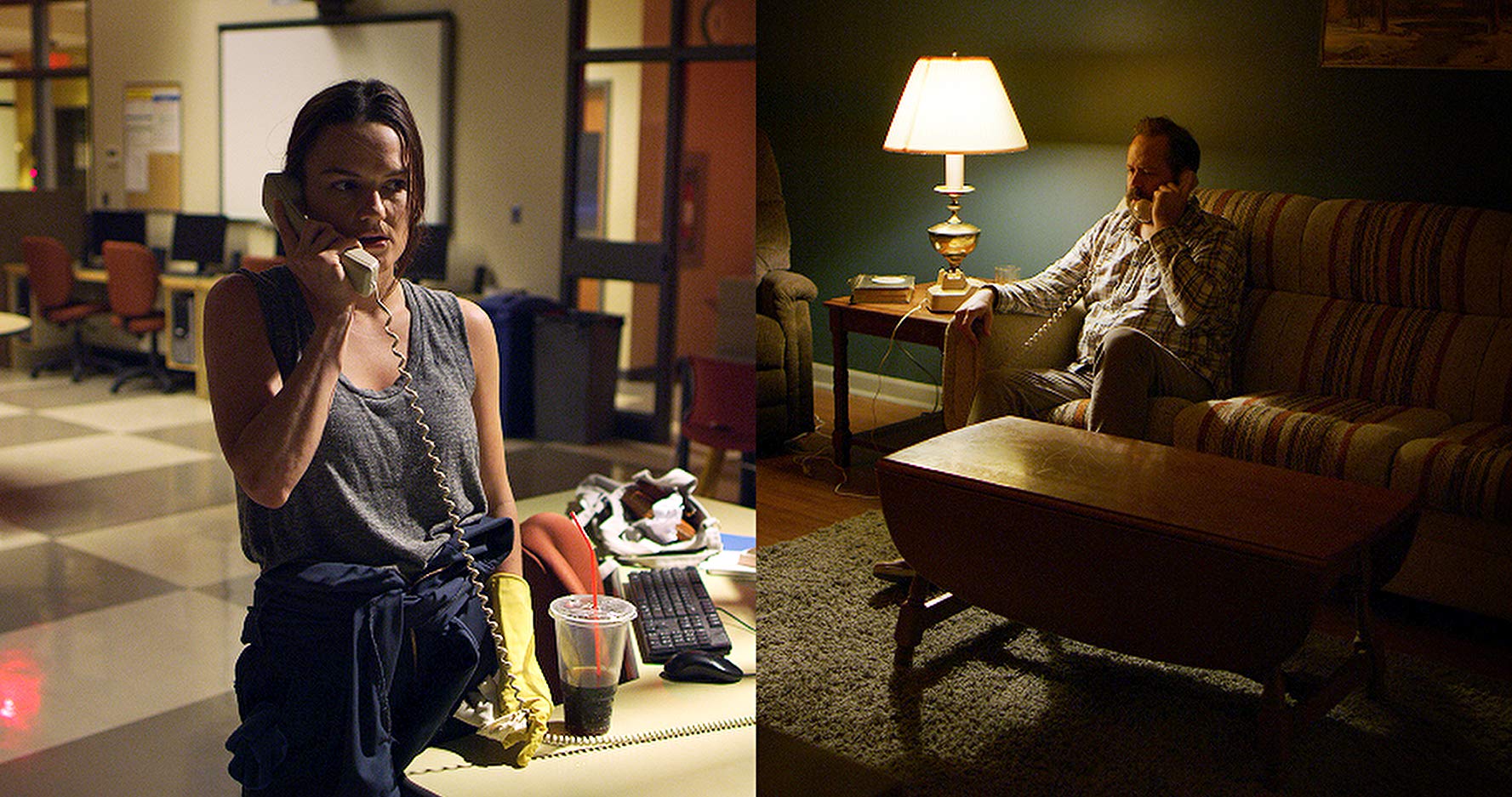
Connection is one of the most important facets of human existence. Knowing that we aren’t alone can be enough to lift a person out of the void and into a space where they can flourish. Often times, that reassuring voice doesn’t even have to be one familiar to us. Last Call transports us to an empty school building where Beth (Sarah Booth), a single mother, works as a night janitor while also completing classes. Beth is struggling to cover this shift for extra money while at home, her 12-year-old son has yet to return from a night out with a friend. As Sarah awaits word on his whereabouts, one of the phones in the building is called by Scott (Daved Wilkins) a divorced alcoholic who believes he is calling a Suicide prevention hotline. Once Beth learns of Scott’s state of mind, it is up to her to play the role of mental health counselor and prevent the stranger from altering both of lives forever.
Last Call’s one-shot camera style has been touted as the film’s calling card and for good reason. Director Gavin Michael Booth and director of photography Seth Wessel-Estes are able to pull of the technical feat of shooting not just one continuous take for an hour plus long film, but two one-shots merged together into one simultaneous narrative. Over the past six years, we have seen the one-shot style used to critical acclaim in films such as Birdman and 1917. The resurgence of the cinematography style could lead one to believe the recent uptick in use could venture toward gimmickry and away from any artistic value. However, Booth and Wessel-Estes manage to use the technique in a creative way that still feels interesting and imaginative. In addition to the one-shot camera work, Last Call uses a split screen to juxtapose its two main characters as their stories unfold and eventually intersect. This particular technique isn’t just used to show us both Beth and Scott simultaneously though, it is also used to communicate to the audience visually by switching perspective depending on the strength of the connection between the two. When Beth and Scott are speaking to one another attentively, the split switches from a horizontal line to a vertical one. Once they disconnect from each other for whatever reason, the split reverts back to the traditional horizontal placement. This subtle piece of visual storytelling is a prime example of the care and skill Last Call’s creative forces put into the film’s cinematographic calling care to avoid any repetitiveness or staleness.
This film does have more to offer than its choices in cinematography. Beth and Scott’s stories of familial strife offer a valuable exploration of both perspective and healing. The two find each other fatefully on this random night as they are both dealing with issues with their children. For Beth, she is struggling to juggle work and school as a single mother with a young boy entering puberty. In Scott’s case, he’s dealing with a strained relationship with his daughter and a lost one with his young son. When Scott calls Beth at his wits end, contemplating suicide, for a moment they find healing with each other. Beth’s ability to get Scott to open up to her and share his story, his feelings for his family and all that he’s lost gives him a chance to find solace away from the bottle for a moment and Beth some perspective on her own issues at home, a point the film makes clear in its ending. While she thought her own trouble that night with her son was the worst thing she could possibly be experiencing, through providing empathy for Scott, she found that things could always be worse. This gained sense of perspective allowed her to be appreciative of what she had, no matter how challenging things could be at times. In its themes, Last Call provides an illustration of how both concepts work in the world which we inhabit off-screen. The power of community in aiding the human spirit is commonly cited from group therapy to professional networking to the theatrical experience. Connecting with the like-minded provides a sense of belonging and safety in knowing we are not alone. In each other, Beth and Scott solace in another who was also hurting in a similar way.
Sarah Booth is fantastic as Beth, offering an emotionally resonant performance. As her character moves from confusion to worry to sadness to panic, Booth manages to be convincing at every turn culminating in the film’s tense conclusion. Director Gavin Michael Booth succeeds in not just crafting a film with a technically strong visual aspect, but one that conveys the psychological complexity of addiction and the nail-biting intensity of what it is like to race against time in an effort to save a life. The inventiveness of Last Call’s cinematography even extends to the film’s score as composer Adrian Ellis recorded the film’s music live in real time similar to how it was shot so that both would have a similar feel. Last Call is a sight to behold with enough thematic depth to carry it past being a simple one-shot wonder.
Image: Mimetic Entertainment

